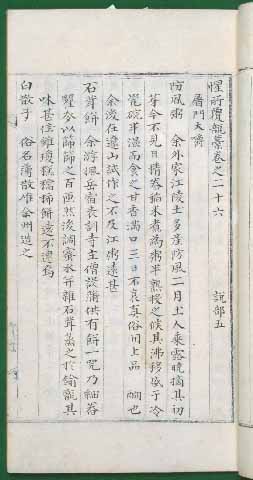Domundaejak facts for kids
Domundaejak (hangul: 도문대작; hanja: 屠門大嚼) is a special book about food written by a person named Heo Gyun in 1611. It's like an old food blog or a collection of food reviews! This book is part of a bigger collection called Seongseobubugo.
Heo Gyun wrote Domundaejak when he was sent away from his home to a place called Hamyel (which is now Iksan) near the sea. While he was there, he had to eat very simple food. This made him remember all the delicious dishes he used to enjoy. So, he decided to write about them!
The name Domundaejak is interesting. Domun means "the butcher's door," and daejak means "chewing loudly." So, the whole title means something like "licking your lips by the butcher's door," imagining all the tasty meat you can't eat right now. It's about craving food you miss!
This book talks about 117 different kinds of food. It mentions 11 types of tteok (rice cakes), 30 kinds of fruit, 5 types of meat, 40 kinds of seafood, 25 types of vegetables, and 5 other foods. For each food, Heo Gyun wrote down where it came from, when it was best to eat, how it was made, what it looked like, and how it tasted.
What's Inside the Book?
Domundaejak describes and comments on the best dishes from different parts of Korea. It also talks about special foods, vegetables, fruits, and fish from various places. The book is mainly divided into sections like "Fruits," "Fish," and "Crops" (which includes vegetables and grains).
Fruits
This section lists 30 different fruits. It talks about common fruits from the Joseon period, like chestnuts and jujubes. It also tells you where these fruits were grown. For example, it mentions 6 types of mandarins from Jeju-do:
- geumgyul (금귤)
- gamgyul (감귤)
- cheonggyul (청귤)
- yugam (유감)
- yuja (유자)
- gamnyu (감류) – a type of persimmon.
Meat
The book describes some very rare and special meats. These include bear's paw, deer tail, deer tongue, pheasant meat, and even leopard placenta. It also tells you where these unique ingredients were found.
Seafood
This part of the book lists 40 different kinds of seafood. It talks about fish like carp, gray mullet, Chinese herring, sweetfish, cod, and mackerel. It also mentions shellfish like clams and crabs. Heo Gyun wrote about how each seafood tasted and where it was caught.
Here are some examples of seafood and their famous locations:
- Han River: gray mullet, Korean sword fish, blowfish, Coreoperca herzi
- Yangpyeong: Kumrinoe
- Imcheon, Hanshan (in Chungcheong), and Impie (in Jeolla): Whitebait
- Asan: Yellow corvina
- Yellow Sea: Zaha, Spiny lobster, Kodoueo, Herring, Croaker, Yellow corvina fish, fingerling, small octopus, Jineo
- Gangneung: Carp, Lenok, Sardine
- Samcheok: Crab (These crabs were said to be as big as small dogs, straight like arrows, and sweet. People often dried them into jerky.)
- Sea of Japan: Bangaeo, Salmon, Trout, Nuruchi, Halibut, flatfish, Sweetfish, Salted salmon eggs
- Northern areas: Trout, Paldaeo
- Heungddok, Buan (in Jeolla): Squid, Douha
- Yeongnam: Eungueo
- Nyongbyon (in Pyongan): Nulchi
Vegetables
The book lists 26 different vegetables. It includes common ones like ginger and mustard. Just like with fruits and seafood, it tells you where these vegetables were grown.
Traditional Snacks (Jogwa)
Jogwa (조과; 造果) is a term for all traditional Korean snack foods. Today, people often call them hangwa to tell them apart from modern cakes. One type of jogwa is yumilgwa (유밀과, 유과; 油蜜果, 油菓). These snacks were often made for special events, parties, or when guests visited.
Some examples of yumilgwa mentioned are:
- yakgwa (약과; 藥果)
- daegye (대계; 大桂)
- jungbaeggi (중배끼; 中桂果)
- hongsanja (홍산자; 紅癎子)
- baeksanja (백산자; 白癎子)
- frozen desserts (빙과; 氷果)
- gwagwa (과과; 瓜果)
- bongjeopgwa (봉접과; 蜂蝶果)
- mandu-gwa (만두과; 饅頭果)
The book also talks about other snacks like jeungbyeong (증병; 蒸餠), wolbyeong (월병; 月餠), sambyeong (삼병; 蔘餠), songoyumil (송고유밀, 송기떡; 松膏油蜜), and jabyeong (자병, 전병; 煮餠). These were found in a place called Seoeul (not the modern Seoul).
Finally, it mentions yaksik (약식; 藥食). This was a special food given to crows on the 15th day of the Lunar New Year. People in China even learned this recipe and called it goyeoban.


